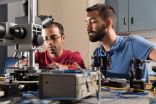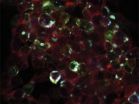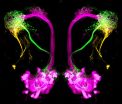(Press-News.org) GALVESTON, Texas -- In the largest study to date evaluating outcomes of Hispanic women with endometrial uterine cancer, researchers at the University of Texas Medical Branch at Galveston have found that Hispanic women in the United States were significantly less likely to survive the cancer than non-Hispanic white women.
A total of 69,764 women diagnosed with endometrial cancer between 2000 and 2010 were included in this study of public-use data from the National Cancer Institute's Surveillance, Epidemiology, and End Results Program. The study is available online in the December issue of Gynecologic Oncology.
According to Dr. Ana M. Rodriguez, assistant professor of obstetrics and gynecology at UTMB and lead author, the purpose of the study was to determine whether demographic factors, tumor characteristics, and treatment influence the endometrial cancer-specific survival of Hispanic women compared with non-Hispanic white women. Results can be generalized to the entire U.S. population.
Endometrial cancer is the most common malignancy of the female reproductive organs. It begins in the cellular lining, the endometrium, of the uterus.
"Most research to date has focused on comparisons of white and black women with endometrial cancer" Rodriguez said, noting that very few studies have examined the age distribution, disease presentation, and endometrial cancer outcomes among Hispanic women.
"While the incidence of endometrial cancer is higher in non-Hispanic white women, we found that minority patients tend to be diagnosed with more aggressive cancer. Early detection is vital to improving endometrial cancer survival as most of the disparity was due to the progression of the disease," she said. "Increased efforts are needed to improve education and increase access to early care for Hispanic women."
Currently there is no screening test for endometrial cancer like there is for cervical cancer (the Pap smear). Endometrial cancer diagnosis is usually the result of a woman's coming to her doctor with symptoms like unusual bleeding or discharge. Endometrial tissue sample biopsy is then usually performed to test for cancer.
The UTMB research suggests that Hispanic women don't seek medical attention promptly upon experiencing symptoms, thus allowing the cancer to progress to a more deadly stage instead of addressing it early.
In their analysis, researchers found that U.S.-born, foreign-born, and birthplace-unknown Hispanics presented with the disease at a younger age (under 50 years) compared to non-Hispanic whites. The data also suggested that a higher percentage of Hispanic women had late stage disease (stage 3 or 4) and more aggressive cancer cells compared to non-Hispanic whites.
The survival curves showed that Hispanic ethnicity, whether a woman is U.S.- or foreign-born, is associated with less favorable outcomes than being non-Hispanic white.
The National Cancer Institute's SEER Program includes 18 population-based cancer registries covering approximately 28 percent of the U.S. population. This study was supported by the Comparative Effectiveness Research on Cancer in Texas Project. CERCIT is part of a new area of research that examines cancer care practices that lead to both good and poor health outcomes and identifiies gaps in services for different populations.
INFORMATION:
Other authors of the paper include Dr. Kathleen M. Schmeler, Department of Gynecologic Oncology and Reproductive Medicine at The University of Texas MD Anderson Cancer Center, and Yong-Fang Kuo, Department of Preventive Medicine and Community Health at UTMB. Funding was provided by the Cancer Prevention Research Institute of Texas.
The University of Texas Medical Branch
Office of Marketing and Communications
301 University Boulevard, Suite 3.518
Galveston, Texas 77555-0144
http://www.utmb.edu
ABOUT UTMB HEALTH: Texas' first academic health center opened its doors in 1891 and today comprises four health sciences schools, three institutes for advanced study, a research enterprise that includes one of only two national laboratories dedicated to the safe study of infectious threats to human health, and a health system offering a full range of primary and specialized medical services throughout Galveston County and the Texas Gulf Coast region. UTMB Health is a component of the University of Texas System and a member of the Texas Medical Center.
A team of researchers from the University of California, San Diego have demonstrated a way to emit and control quantum light generated using a chip made from silicon--one of the most widely used materials for modern electronics.
The UC San Diego researchers recently described their new device's performance online in the journal Nature Communications, available via Open Access .
The researchers say practical applications of quantum optics will seem more feasible if devices for generating and controlling these photons can be manufactured using conventional materials ...
It's the most basic of ways to find out what something does, whether it's an unmarked circuit breaker or an unidentified gene -- flip its switch and see what happens. New remote-control technology may offer biologists a powerful way to do this with cells and genes.
A team at Rockefeller University and Rensselaer Polytechnic Institute is developing a system that would make it possible to remotely control biological targets in living animals -- rapidly, without wires, implants or drugs.
Today (December 15) in the journal Nature Medicine, the team describes successfully ...
BOSTON (Dec. 16, 2014) -- Extra vitamin E protected older mice from a bacterial infection that commonly causes pneumonia. Microbiologists and nutrition researchers from Tufts University report that the extra vitamin E helped regulate the mice's immune system. The findings, published online in advance of print in the The Journal of Immunology, show promise for studies investigating the effects of vitamin E and infection in humans.
Older adults over age 65 are at high risk for developing pneumonia, an inflammation of the lungs typically caused by infection. The most common ...
A scientific team at UBC and Providence Health Care have genetically engineered mice with less wrinkled skin, despite repeated exposure to wrinkle-inducing ultraviolet (UV) light.
The youthful-looking mice were bred without the gene that produces Granzyme B, an enzyme that immune cells use to destroy harmful pathogens. The UBC-Providence team, led by Professor David Granville and postdoctoral fellow Leigh Parkinson, found that Granzyme B also does harm: When produced and released by skin cells in response to UV light, it triggers the breakdown of collagen, a structural ...
ANN ARBOR--A set of eight hurricane-forecast satellites being developed at the University of Michigan is expected to give deep insights into how and where storms suddenly intensify--a little-understood process that's becoming more crucial to figure out as the climate changes, U-M researchers say.
The Cyclone Global Navigation Satellite System is scheduled to launch in fall 2016. At the American Geophysical Union Meeting in San Francisco this week, U-M researchers released estimates of how significantly CYGNSS could improve wind speed and storm intensity forecasts.
CYGNSS--said ...
Contrary to popular belief, new research suggests that some employees adapt well to pressures caused by changes in the workplace.
Pay cuts, reduced working hours, fewer training and promotion opportunities are just a few of the measures organisations employ to combat economic downturn and industry competition. Where previous research has suggested cut backs result in a demotivated and unhappy workforce, experts from Monash University and The University of Iowa say this might not necessarily be the case.
A new study published in the Journal of Occupational and Organizational ...
A global fleet of composite planes could reduce carbon emissions by up to 15 percent, but the lighter planes alone will not enable the aviation industry to meet its emissions targets, according to new research.
The study, by the Universities of Sheffield, Cambridge and UCL (University College London), is the first to carry out a comprehensive life cycle assessment (LCA) of a composite plane, such as the Boeing Dreamliner 787 or Airbus 350, and extrapolate the results to the global fleet.
The LCA covers manufacture, use and disposal, using publicly available information ...
A team of Chinese and Italian scientists has joined efforts to provide a key to the understudied phaleratus group of blister beetles. During their research the scientists have also discovered a new species from the genus Hycleus, which they named after Marco Polo, as a tribute to their collaboration during the Ph.D. studies. The study was published in the open access journal ZooKeys.
The phaleratus group to which the new species Hycleus marcipoli belongs, is part of the Meloidae family commonly known as the blister beetle family. The representatives of this group get ...
This news release is available in German. Whether an odor is pleasant or disgusting to an organism is not just a matter of taste. Often, an organism's survival depends on its ability to make just such a discrimination, because odors can provide important information about food sources, oviposition sites or suitable mates. However, odor sources can also be signs of lethal hazards. Scientists from the BMBF Research Group Olfactory Coding at the Max Planck Institute for Chemical Ecology in Jena, Germany, have now found that in fruit flies, the quality and intensity of ...
Researchers studied 414 people with severe dementia along with their carers in England, Estonia, Finland, France, Germany, the Netherlands, Spain and Sweden. The study gathered information on quality of life, activities of daily living such as bathing, feeding and dressing and presence of depressive symptoms using standardised measures.
In the groups studied, 37% of the 217 people living in the community showed signs of depression compared to 23% of the 197 in care homes. It is one of the few studies comparing similar groups of people living at home and in nursing homes.
Professor ...





